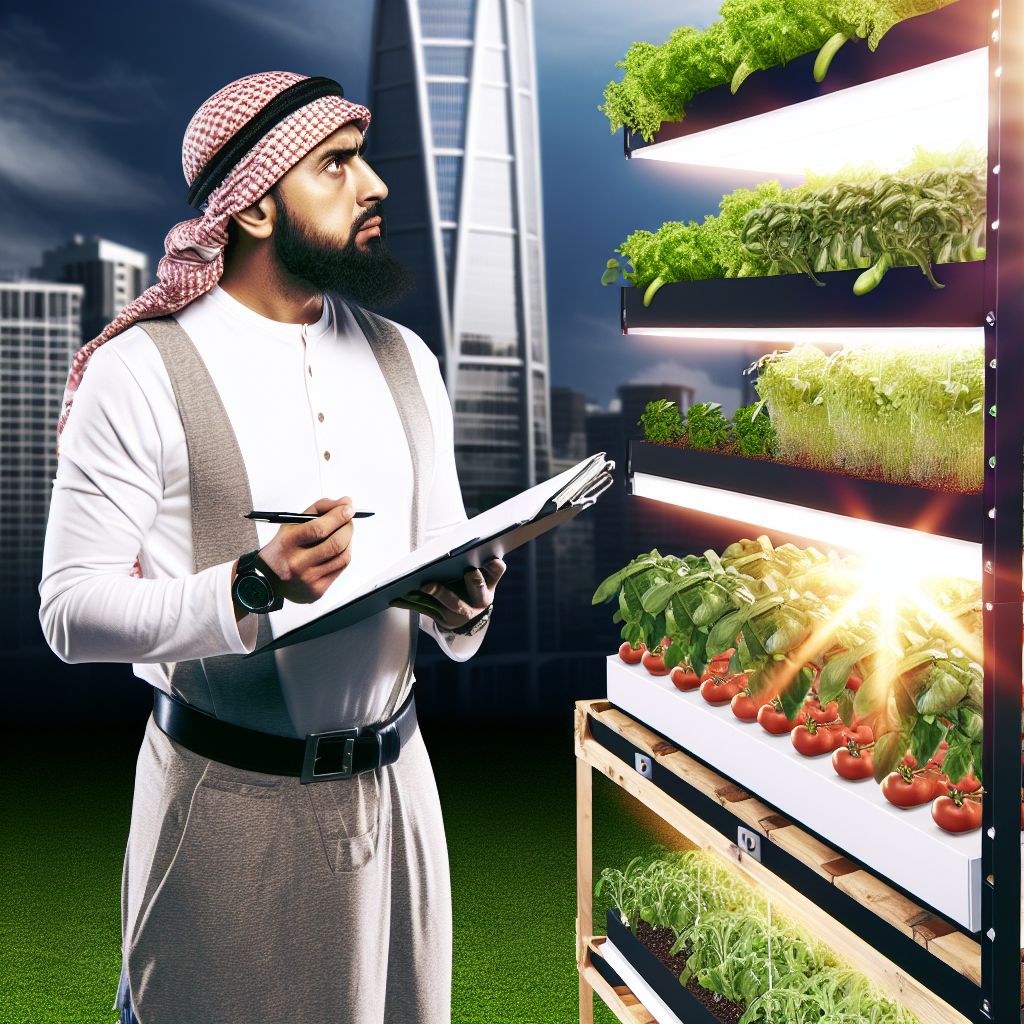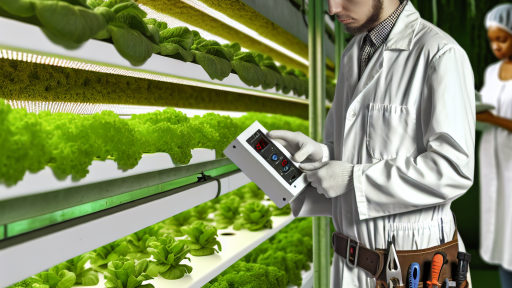Introduction to Vertical Farming
Definition of Vertical Farming
Vertical farming is a modern agricultural method.
It involves growing crops in vertically stacked layers.
This technique can utilize controlled environments.
These environments often incorporate hydroponics or aeroponics.
Moreover, vertical farming maximizes space usage.
Importance of Vertical Farming
Vertical farming addresses the challenge of food scarcity.
It enables food production in urban areas.
Consequently, it reduces transportation costs and emissions.
This method optimizes resource use, including water and nutrients.
Additionally, it can produce food year-round, independent of climate.
Benefits of Implementing Vertical Farming
One key benefit is increased crop yield per square foot.
This system minimizes the land required for agriculture.
Furthermore, it can maintain sustainable practices.
Vertical farms often use less water than traditional farms.
Additionally, they can significantly reduce pesticide use.
Transform Your Agribusiness
Unlock your farm's potential with expert advice tailored to your needs. Get actionable steps that drive real results.
Get StartedChallenges of Vertical Farming
Despite its advantages, vertical farming faces challenges.
Initial setup costs can be quite high.
Technology maintenance requires skilled personnel.
Moreover, energy consumption may be a concern.
However, advancements aim to enhance energy efficiency.
Future of Vertical Farming
The future looks promising for vertical farming.
Innovations continue to improve efficiency and sustainability.
As technology advances, costs will likely decrease.
This could make vertical farming accessible to more farmers.
Ultimately, it holds significant potential for global food security.
Benefits of Vertical Farming for Sustainable Agriculture
Maximizing Space Efficiency
Vertical farming allows growers to utilize space more effectively.
This method increases crop yield per square foot significantly.
Moreover, it minimizes land use and encourages urban farming.
By stacking crops vertically, farmers can grow more produce in limited areas.
This approach is crucial in densely populated cities.
Water Conservation
Vertical farms significantly reduce water usage compared to traditional farming.
Hydroponic and aeroponic systems recirculate water efficiently.
As a result, they use up to 90% less water.
This conservation is vital in areas facing water shortages.
Additionally, automated systems monitor and manage water usage accurately.
Reduction of Carbon Footprint
Vertical farming lowers the carbon footprint of food production.
It reduces the need for transportation by producing food locally.
Furthermore, controlled environments minimize the use of pesticides and fertilizers.
These factors contribute to cleaner air and healthier ecosystems.
Showcase Your Farming Business
Publish your professional farming services profile on our blog for a one-time fee of $200 and reach a dedicated audience of farmers and agribusiness owners.
Publish Your ProfileConsequently, urban inhabitants enjoy fresher produce with less environmental impact.
Year-Round Crop Production
Vertical farms enable continuous crop production regardless of season.
Advanced climate control systems allow farmers to optimize growing conditions.
This consistency leads to a stable food supply.
Consequently, farmers can meet local demands throughout the year.
This approach stabilizes prices and reduces the risk of crop failure.
Enhanced Food Security
Vertical farming plays a key role in enhancing food security.
By producing food close to urban centers, it reduces dependency on large supply chains.
This method mitigates the risk of food shortages.
Additionally, local production systems can respond faster to consumer needs.
Thus, communities can enjoy fresh and nutritious food consistently.
Assessing Suitable Crops for Vertical Farming Systems
Understanding Crop Selection Criteria
Selecting the right crops for vertical farming requires careful consideration.
Crops must fit the unique environment of vertical systems.
Light requirements, growth patterns, and market demand are crucial factors.
Additionally, some crops thrive better in limited space than others.
Ideal Crops for Vertical Farming
Leafy greens are among the best options for vertical farming.
Varieties such as lettuce and spinach grow quickly and efficiently.
Herbs like basil and mint also adapt well to vertical systems.
Moreover, they have short growth cycles and high market value.
Fruiting crops, such as strawberries, can also be successful.
Evaluating Market Demand
Market demand plays a key role in crop selection.
Farmers should analyze local preferences and trends.
For instance, organic produce often sees higher demand.
Additionally, specialty crops can yield premium prices.
Assessing Environmental Conditions
Environmental conditions vary significantly across farms.
Farmers need to evaluate temperature, humidity, and light availability.
These factors influence which crops will flourish in vertical systems.
Using advanced growth lights can help optimize crop performance.
Implementing a Trial Phase
Conducting a trial phase helps identify the best crop choices.
Start with a small batch of various crops to test growth.
Monitor factors like yield, taste, and growth rate throughout the phase.
This data will guide future crop selection and cultivation strategies.
Find Out More: Monitoring and Managing Smart Irrigation Systems
Choosing the Right Technology
Overview of Vertical Farming Technologies
Vertical farming utilizes innovative techniques to produce crops efficiently.
Farmers can choose from various technologies based on their needs.
This section explores popular systems like hydroponics and aeroponics.
Understanding Hydroponics
Hydroponics is a soil-less growing method using nutrient-rich solutions.
This technique boosts plant growth by delivering nutrients directly to roots.
Farmers can grow a wide variety of crops using hydroponic systems.
Moreover, it uses less water compared to traditional farming.
Showcase Your Farming Business
Publish your professional farming services profile on our blog for a one-time fee of $200 and reach a dedicated audience of farmers and agribusiness owners.
Publish Your ProfileIt can significantly increase yield per square foot.
Exploring Aeroponics
Aeroponics suspends plants in the air and mists their roots with nutrients.
This method also conserves water by minimizing evaporation.
Aeroponics promotes faster plant growth and healthier crops.
Additionally, it can reduce labor costs and space requirements.
Other Vertical Farming Methods
Many alternative methods exist beyond hydroponics and aeroponics.
- Container farming allows farming in limited spaces.
- Stacked or tower systems maximize vertical space effectively.
- Integrating aquaponics combines fish farming with plant cultivation.
Each solution offers unique advantages for farmers seeking innovation.
Factors to Consider When Choosing Technology
Several factors influence the selection of the right technology.
Assess the scale of production needed for your operation.
Consider your budget for initial investment and ongoing costs.
Evaluate space availability and local climate conditions.
Finally, research the specific crop types you wish to grow.
Learn More: Predictive Analytics for Pest Control
Designing an Efficient Vertical Farm Layout for Maximum Space Utilization
Understanding Vertical Farm Layouts
A vertical farm layout maximizes space efficiently.
This method utilizes vertical space to grow more crops.
Modern designs support various growing techniques.
Understanding your space needs is crucial.
Planning Your Vertical Farm
Begin by assessing available space for the farm.
Consider factors like sunlight exposure and ventilation.
Next, determine the types of crops you want to grow.
Select crops based on growth patterns and space requirements.
Choosing the Right Growing Systems
Several growing systems support vertical farming.
Hydroponic systems use nutrient-rich water instead of soil.
Aeroponic systems mist the roots for optimal growth.
Evaluate the benefits of each system before deciding.
Arranging Plant Shelves and Towers
Arrange plant shelves or towers to maximize light access.
Ensure adequate space for maintenance and harvesting.
Employ staggered arrangements for better airflow.
This design method promotes healthy plant growth.
Utilizing Technology
Technology plays a key role in modern vertical farms.
Consider using sensors to monitor environmental conditions.
Automated systems can optimize watering and lighting.
Data analytics can improve efficiency over time.
Incorporating Sustainable Practices
Sustainable practices enhance vertical farm efficiency.
Utilize recycled materials for construction whenever possible.
Invest in renewable energy sources to power operations.
This approach reduces the farm’s overall carbon footprint.
Learn More: Future Of Robotics In Agriculture
Understanding the Cost-Benefit Analysis of Vertical Farming Implementation
Introduction to Cost-Benefit Analysis
Cost-benefit analysis evaluates the financial implications of vertical farming.
It helps farmers assess potential profitability and feasibility.
Showcase Your Farming Business
Publish your professional farming services profile on our blog for a one-time fee of $200 and reach a dedicated audience of farmers and agribusiness owners.
Publish Your ProfileThe analysis involves comparing costs with expected benefits.
Farmers must consider both tangible and intangible factors.
Identifying Costs of Vertical Farming
Initial setup costs are a significant factor in vertical farming.
These include infrastructure, equipment, and technology expenses.
Additionally, farmers will face ongoing operational costs.
Labor, energy, and maintenance costs must also be factored in.
Calculating Potential Benefits
Vertical farming offers numerous potential benefits to farmers.
First, it increases crop yield per square foot significantly.
Second, it dramatically reduces water usage compared to traditional methods.
Third, farmers can grow crops year-round, enhancing profitability.
Furthermore, crops can be grown closer to urban centers, reducing transportation costs.
Assessing Environmental Impact
The environmental impact is a crucial aspect of vertical farming.
Vertical farms often use fewer pesticides and fertilizers.
This results in healthier produce and less pollution.
The reduced carbon footprint from transportation is another benefit.
Evaluating Risk Factors
Every investment carries inherent risks that farmers must consider.
Technological failures can impact production and profitability.
Market acceptance of vertically grown produce is also a concern.
Additionally, fluctuating energy costs can affect operational expenses.
Making Informed Decisions
Farmers should carefully consider the findings from their analysis.
Engaging with agricultural consultants can provide valuable insights.
Networking with other vertical farmers offers practical advice and experiences.
A well-rounded approach ensures more informed decision-making.
Delve into the Subject: Vertical Farming Solutions for Urban Agricultural Needs

Best Practices for Nutrient Management in Vertical Farming
Understanding Nutrient Needs
Knowing your plants’ nutrient requirements is essential.
Each type of crop has unique needs for growth.
Conduct soil tests to understand nutrient levels.
Monitor plant health to identify deficiencies early.
Selecting Nutrient Solutions
Choose high-quality nutrient solutions for your crops.
Liquid fertilizers often provide essential nutrients quickly.
Organic options like compost teas are also effective.
Balance macro and micronutrients based on crop type.
Implementing Efficient Delivery Systems
Set up an efficient nutrient delivery system.
Consider using drip irrigation for precision application.
This method reduces waste and optimizes nutrient uptake.
Regularly check and adjust the system for leaks.
Monitoring and Adjusting Nutrient Levels
Regularly monitor nutrient levels in your system.
Utilize tools like EC meters to measure nutrient concentration.
Adjust nutrient solutions based on plant growth stages.
Track environmental factors that affect nutrient absorption.
Showcase Your Farming Business
Publish your professional farming services profile on our blog for a one-time fee of $200 and reach a dedicated audience of farmers and agribusiness owners.
Publish Your ProfileTraining and Education
Ensure your team is trained in nutrient management techniques.
Provide resources for ongoing education in vertical farming.
Encourage sharing of successful practices within your team.
This approach fosters a culture of continuous improvement.
Marketing Strategies for Vertical Farms: Reaching Your Target Audience
Identifying Your Target Market
Start by defining your ideal customer profile.
Consider factors such as demographics and location.
Next, examine lifestyle choices and purchasing behaviors.
Finally, use surveys or focus groups to gather insights.
Creating a Unique Value Proposition
Determine what sets your vertical farm apart.
Highlight key features, such as sustainability and freshness.
Communicate the benefits clearly to your audience.
Ensure your messaging resonates with their values.
Utilizing Social Media Marketing
Select platforms popular with your target audience.
Share engaging content that showcases your products.
Consider using video tours of your farm to attract interest.
Create regular posts to maintain audience engagement.
Collaborating with Local Businesses
Partner with local restaurants to feature your produce.
Join farmers’ markets to increase visibility in the community.
Engage with local chefs to create unique recipes.
Utilize these partnerships for cross-promotional opportunities.
Leveraging Online Sales Channels
Develop an online store to reach a wider audience.
Offer subscription services for regular customers.
Utilize e-commerce platforms to streamline sales.
Incorporate customer reviews to build trust and reliability.
Implementing Community Engagement Programs
Create educational workshops about vertical farming.
Invite community members to farm tours.
Engage schools for educational programs on sustainability.
Promote these events through local media channels.
Analyzing and Adjusting Strategies
Regularly assess the effectiveness of your marketing strategies.
Use analytics tools to monitor engagement and sales.
Gather feedback from customers to improve offerings.
Adjust your approach based on data-driven insights.
Regulatory Considerations and Compliance in Vertical Farming
Understanding the Regulatory Landscape
Vertical farming operates within a unique regulatory environment.
Each jurisdiction has specific regulations affecting farming practices.
Farmers must stay informed about local, state, and federal laws.
Venturing into vertical farming requires thorough research.
Understanding zoning laws is essential for compliance.
Make sure your location permits vertical farming installations.
Health and Safety Regulations
Health regulations govern the production of food items.
Farmers must comply with local health department standards.
Showcase Your Farming Business
Publish your professional farming services profile on our blog for a one-time fee of $200 and reach a dedicated audience of farmers and agribusiness owners.
Publish Your ProfileSanitation practices must meet FDA guidelines for produce safety.
Regular inspections may occur to ensure compliance.
Maintaining records of sanitation practices is beneficial.
Have procedures in place to handle any food safety issues.
Environmental Considerations
Environmental regulations impact waste management in vertical farms.
Proper disposal of waste is crucial to avoid penalties.
Farms must also manage water use in an efficient manner.
Consider systems for recycling water to conserve resources.
Compliance with air quality regulations is essential.
Utilize sustainable practices to minimize environmental impact.
Licensing and Permits
Acquiring the right licenses is a critical step.
Farmers may need specific permits for equipment installations.
Research local farming associations for licensing requirements.
Compliance with electrical and construction codes is necessary.
Regularly review permit renewals to remain compliant.
Best Practices for Compliance
Staying organized helps streamline compliance efforts.
Maintain comprehensive records of all farming activities.
Schedule routine audits of your practices and equipment.
Invest in compliance training for your staff.
Engage with legal advisors familiar with agricultural laws.
Review changes in regulations on a regular basis.
Case Studies: Successful Vertical Farming Operations Around the World
Urban Farming Innovations in Singapore
AeroFarms is a leading vertical farming company in Singapore.
This company utilizes aeroponic technology to maximize yield.
Their operations thrive in an urban environment with limited space.
By using indoor farming techniques, they minimize land usage.
Every year, they produce hundreds of thousands of pounds of greens.
Furthermore, they contribute significantly to local food security.
Pioneering Hydroponics in the Netherlands
In the Netherlands, growers like Dutch Greenhouse Group excel in vertical farming.
Their hydroponic systems allow for year-round cultivation of vegetables.
These systems dramatically reduce water usage by recirculating solutions.
The producers have also enhanced energy efficiency through innovative lighting.
As a result, they consistently yield high-quality produce for the market.
This success helps position the Netherlands as a leader in sustainable farming.
Community-Based Farming in Japan
Plant Factory Corporation is a notable example in Japan.
This organization integrates community involvement in its vertical farming model.
They focus on growing organic vegetables using advanced technology.
Moreover, they foster local employment opportunities through their operations.
Community members actively participate in the farming process.
This engages the public and increases awareness about clean food production.
Technological Advancements in the USA
The United States showcases innovative vertical farming practices.
Showcase Your Farming Business
Publish your professional farming services profile on our blog for a one-time fee of $200 and reach a dedicated audience of farmers and agribusiness owners.
Publish Your ProfileBrightFarms has made impressive strides in urban agriculture.
They create hydroponic greenhouses near major cities.
This strategy dramatically reduces transportation costs and emissions.
BrightFarms supplies fresh produce directly to local grocery stores.
Consequently, they promote sustainable consumption within communities.
Scalable Solutions in Australia
In Australia, Plenty is leading the charge in vertical farming scalability.
They combine data analytics with vertical farming techniques.
This enables optimized growth conditions tailored to specific crops.
Plenty’s farms operate with minimal environmental impact.
Additionally, they focus on producing pesticide-free vegetables.
This commitment resonates well with health-conscious consumers.
Additional Resources
Vertical Farming: Everything You Need to Know | Eden Green
A review on urban agriculture: technology, socio-economy, and policy




